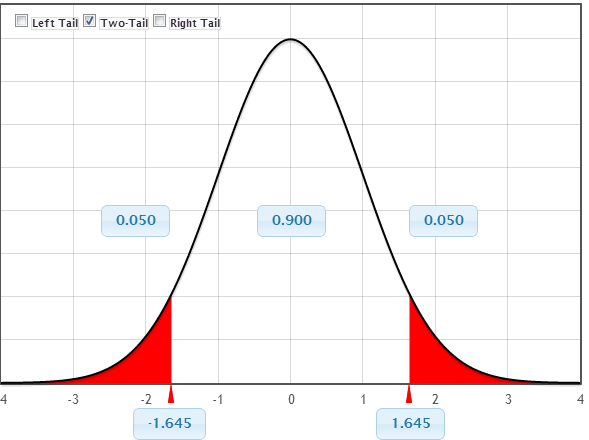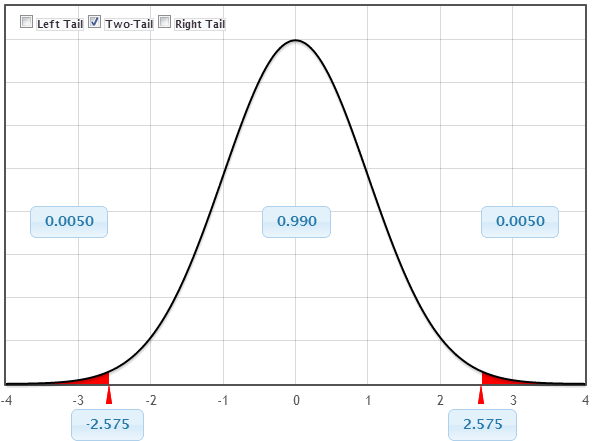[1] 1.644854Hypothesis Tests and Confidence Intervals using Normal Distribution!
STAT 120
How do Malaria parasites impact mosquito behavior?

Mosquitoes are tested with two mouse groups: Malaria-infected (experimental) and Healthy (control)
Stages of malaria in mice:
Stage 1: Non-infectious (Days 1-8)Stage 2: Infectious (Days 9-28)Response Variable: Whether the mosquito approaches a human.
Research Hypothesis
Research Questions: Do mosquitoes behave differently around malaria-infected versus healthy mice? Does the infection stage affect their behavior?
Malaria parasites would benefit if
- Mosquitoes approached humans
less oftenafter being exposed, but before becoming infectious, because humans are risky - Mosquitoes approached humans
more oftenafter becoming infectious, to pass on the infection
Days 1-8
We’ll first look at the mosquitoes before they become infectious (days 1-8).
\(p_C:\) proportion of controls to approach human
\(p_E:\) proportion of exposed to approach human
What are the relevant hypotheses?
A. \(\mathrm{H}_0: p_{\mathrm{E}}=p_{\mathrm{C}}, \mathrm{H}_{\mathrm{a}}: p_{\mathrm{E}}<p_{\mathrm{C}}\)
в. \(\mathrm{H}_0: p_{\mathrm{E}}=p_{\mathrm{C}}, \mathrm{H}_{\mathrm{a}}: p_{\mathrm{E}}>p_{\mathrm{C}}\)
- \(\mathrm{H}_0: p_{\mathrm{E}}<p_{\mathrm{C}}, \mathrm{H}_{\mathrm{a}}: p_{\mathrm{E}}=p_{\mathrm{C}}\)
D. \(H_0: p_{\mathrm{E}}>p_{\mathrm{C}}, \mathrm{H}_{\mathrm{a}}: p_{\mathrm{E}}=p_{\mathrm{C}}\)
Click for answer
The correct answer is A. (since it favors parasites if exposed mosquitoes do not approach humans during this stage)Sample data
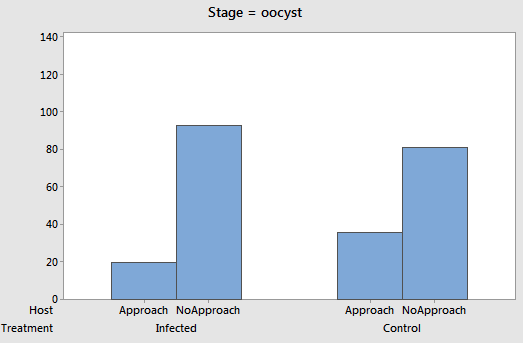
p̂E - p̂C = 20/113 - 36/117 = 0.177 - 0.308 = -0.131
Randomization Distribution
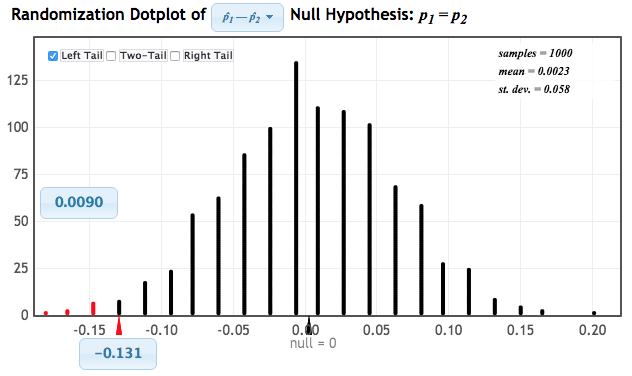
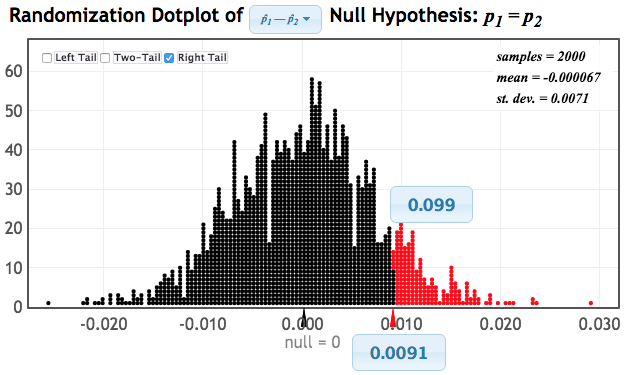
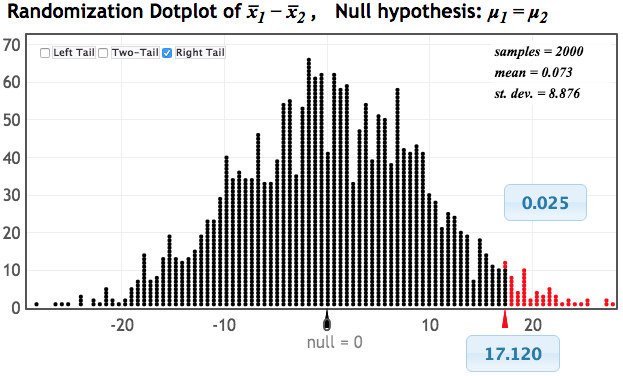
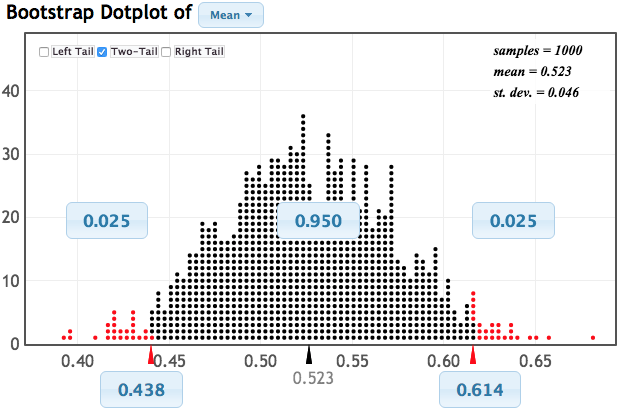
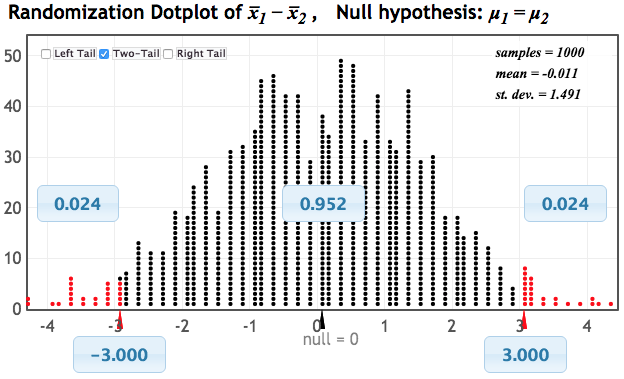
What do you notice?
Central Limit Theorem (CLT)
For random samples with a sufficiently large sample size, the distribution of sample statistics for a mean or a proportion is normally distributed
The catch: “sufficiently large sample size”
The more skewed the original distribution of data/population is, the larger \(n\) has to be for the CLT to work
- For quantitative variables that are not very skewed, \(\boldsymbol{n} \geq \mathbf{3 0}\) is usually sufficient
- For categorical variables, counts of at least 10 within each category is usually sufficient
Which normal distribution?
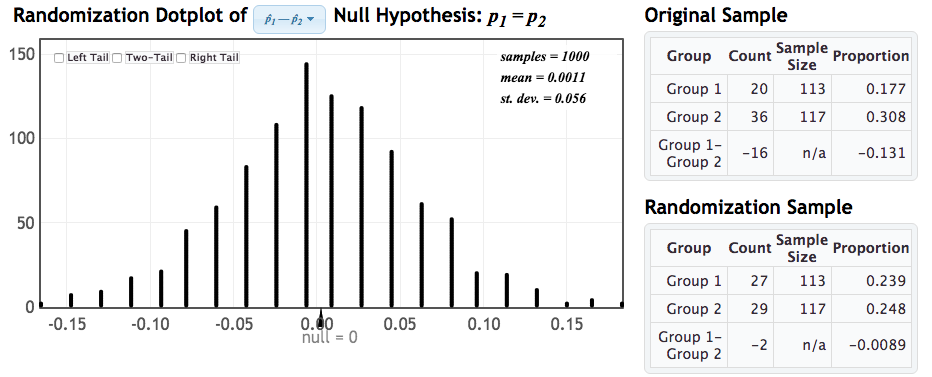
Click for answer
The correct answer is B. (since the distribution is centered at 0 and has standard deviation of 0.056)Statkey: p-value from N(null, SE)
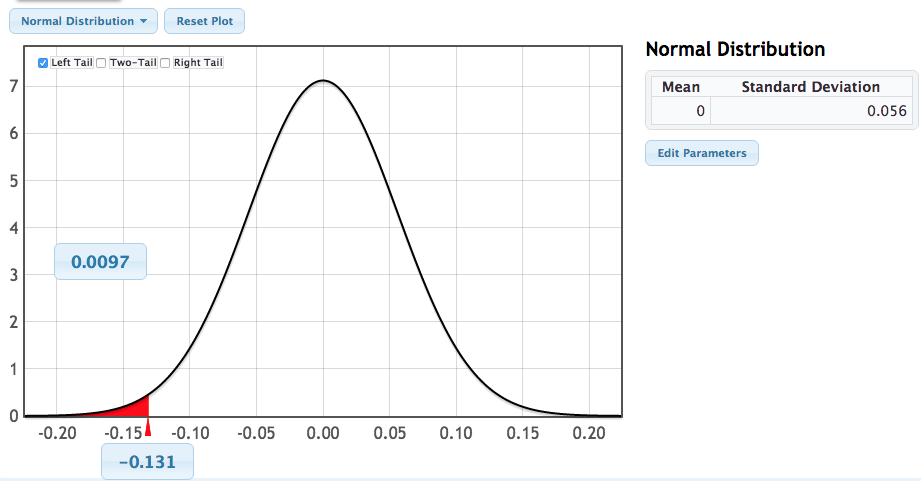
Connecting Normal model to hypothesis tests
Suppose: randomization distribution is bell shaped.
Center: hypothesized null parameter valueSpread: the standard error given in the randomization graph (or by formula)P-value: computed from the normal model the “usual” way - the chance of being as extreme, or more extreme, than the observed statistic.
Standardized Statistic
The standardized test statistic (also known as a z-statistic) is \[\begin{align*} z=\frac{\text { statistic }-\text { null }}{S E} \end{align*}\]
Calculating the number of standard errors a statistic is from the null lets us assess extremity on a common scale.
Malaria and Mosquitos
Does infecting mosquitoes with Malaria actually impact the mosquitoes’ behavior to favor the parasite?
- After the parasite becomes infectious, do infected mosquitoes approach humans more often, so as to pass on the infection?
Days 9 – 28
For the data after the mosquitoes become infectious (Days \(9-28\)), what are the relevant hypotheses?
\[\begin{align} \boldsymbol{p}_{C}: & \text{proportion of controls to approach human}\\ \boldsymbol{p}_{E}: & \text{proportion of exposed to approach human} \end{align}\]
\[\begin{aligned} A. \quad & \mathrm{H}_0: p_{\mathrm{E}}=p_{\mathrm{C}}, \mathrm{H}_{\mathrm{a}}: p_{\mathrm{E}}<p_{\mathrm{C}} \\ B. \quad & \mathrm{H}_0: p_{\mathrm{E}}=p_{\mathrm{C}}, \mathrm{H}_{\mathrm{a}}: p_{\mathrm{E}}>p_{\mathrm{C}} \\ C. \quad & \mathrm{H}_0: p_{\mathrm{E}}<p_{\mathrm{C}}, \mathrm{H}_{\mathrm{a}}: p_{\mathrm{E}}=p_{\mathrm{C}} \\ D. \quad & \mathrm{H}_0: p_{\mathrm{E}}>p_{\mathrm{C}}, \mathrm{H}_{\mathrm{a}}: p_{\mathrm{E}}=p_{\mathrm{C}} \end{aligned}\]Click for answer
The correct answer is B. (since it now favors parasites if exposed mosquitoes approach humans more during this stage)Before and after

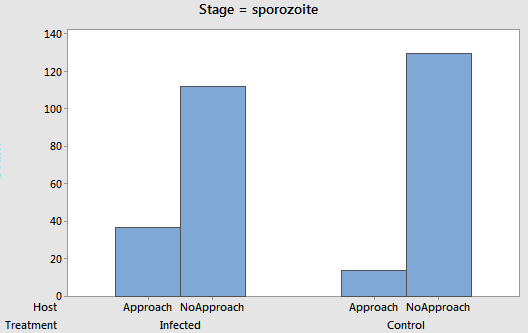
p̂E - p̂C =
20/113 - 36/117 =
0.177 - 0.308 = -0.131
p̂E - p̂C =
37/149 - 14/144 =
0.248 - 0.097 = 0.151
Is the difference significant?
The difference in proportions is 0.151 and the standard error is 0.05. Is this significant?
A. Yes
B. No
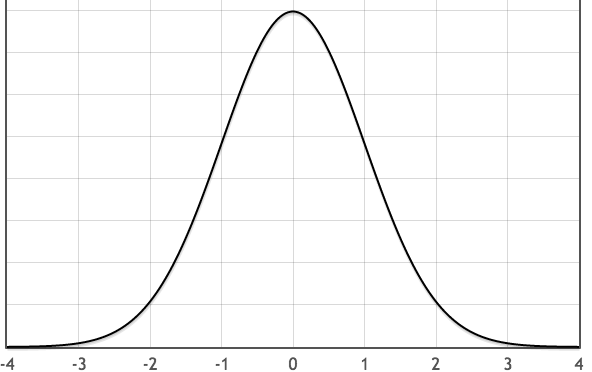
Malaria and Mosquitoes
It appears that mosquitoes infected by malaria parasites do, in fact, behave in ways advantageous to the parasites!
- Exposed mosquitos are
less likelyto approach before becoming infectious (so more likely to stay alive) - Exposed mosquitos are
more likelyto approach humans after becoming infectious (so more likely to pass on disease)
Formula for p-values Using N(0,1)
\[\begin{align*} z=\frac{\text { sample statistic }-\text { null value }}{\text { SE }} \end{align*}\]
From original
data
From Ho
From
randomization
distribution
Connecting Normal model to Confidence Intervals
Suppose: bootstrap distribution is bell-shaped.
Center: sample statisticSpread: the standard error given in the bootstrap graph (or by formula)
Bootstrap Distributions
If a bootstrap distribution is normally distributed, we can write it as
A. \(\mathrm{N} (parameter, SD)\)
B. \(\mathrm{N} (statistic, SD)\)
C. \(\mathrm{N} (parameter, SE)\)
D. \(\mathrm{N} (statistic, SE)\)
Click for answer
The correct answer is D. (center = statistic, spread = SE)Connecting Normal model to Confidence Intervals
To get a \(95 \%\) confidence interval we compute: \[statistic \pm 2(SE)\]
Why 2 SE’s?
- \(95 \%\) of all sample means fall within 2 SE’s of the population mean
- The value 2 is a z-score!
- Well, actually the precise z-score under a normal model is \(z=1.96\) instead of 2 !
N(0,1) model
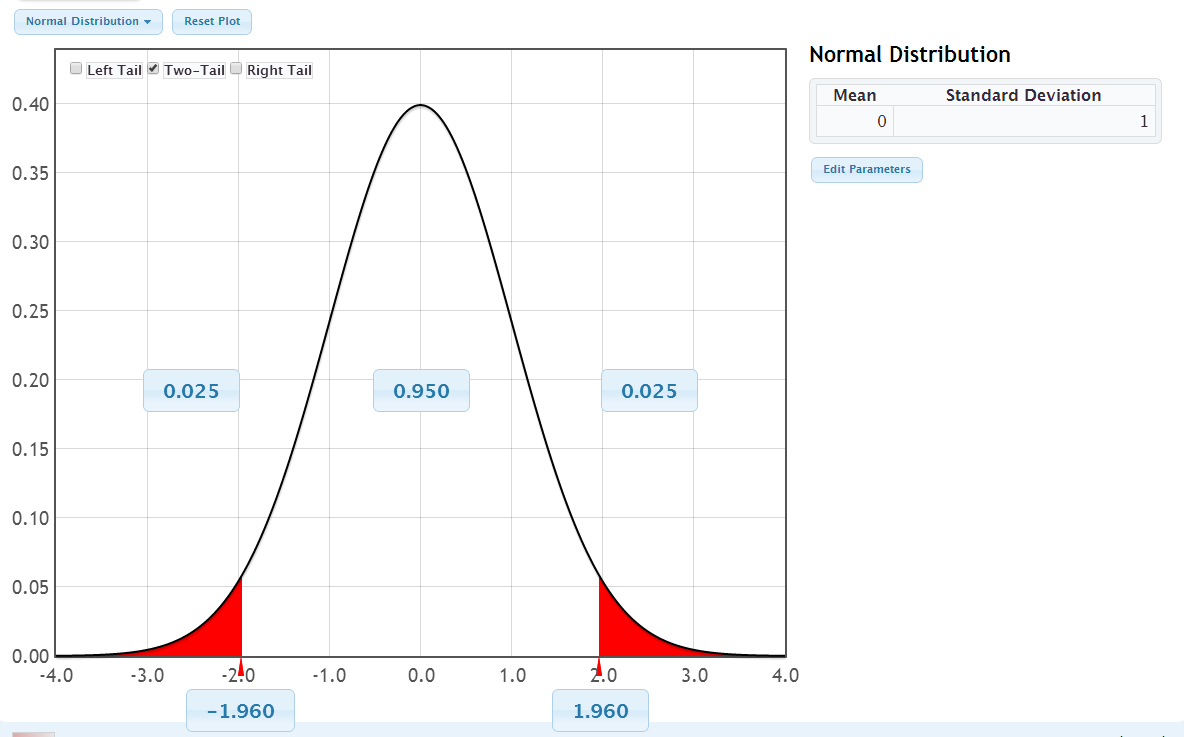
95% of all values fall within 1.96 SE’s of the mean
What if we wanted a 90% CI? What z-score should we use?
Confidence Interval using N(0,1)
If a statistic is normally distributed, we find a confidence interval for the parameter using \[statistic \pm z^* SE\] where the area between \(-z^*\) and \(+z^*\) in the standard normal distribution is the desired level of confidence.
Group Activity 1

- Please download the Class-Activity-16 template from moodle and go to class helper web page
30:00
